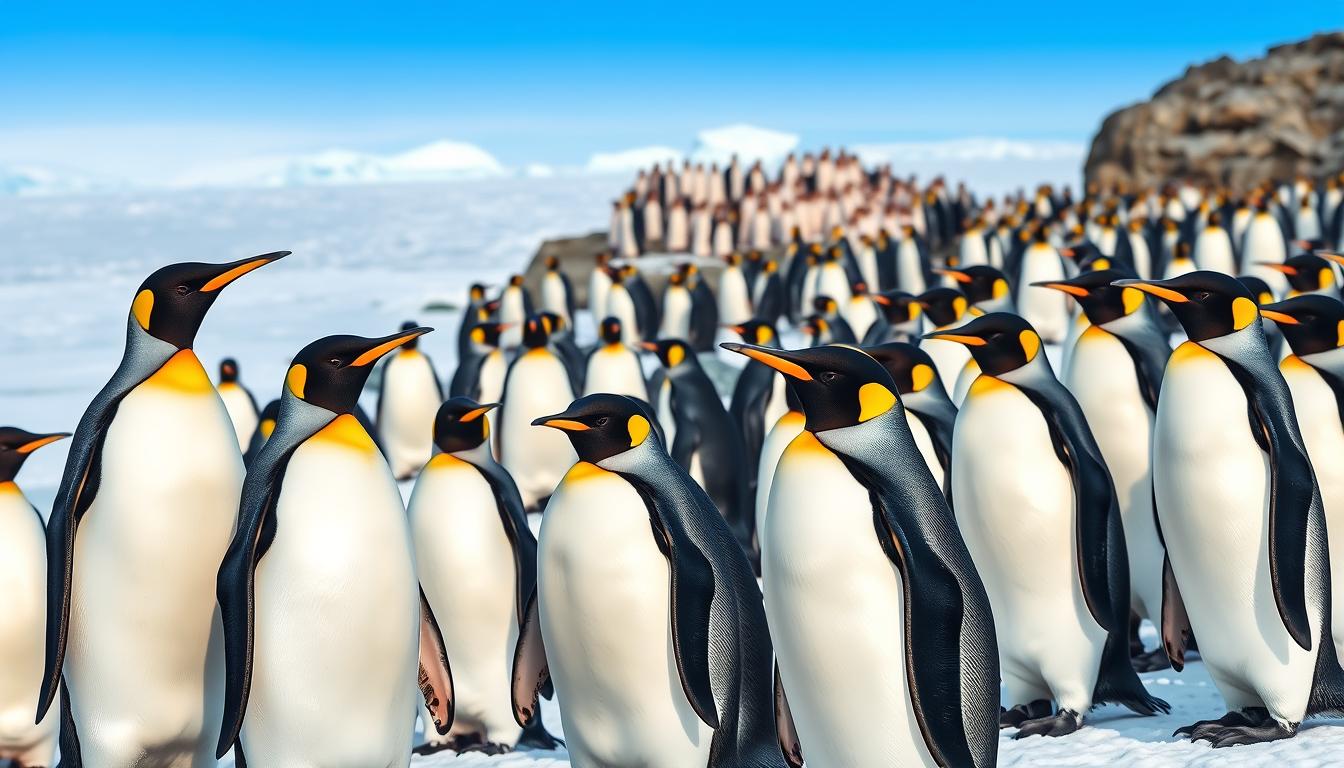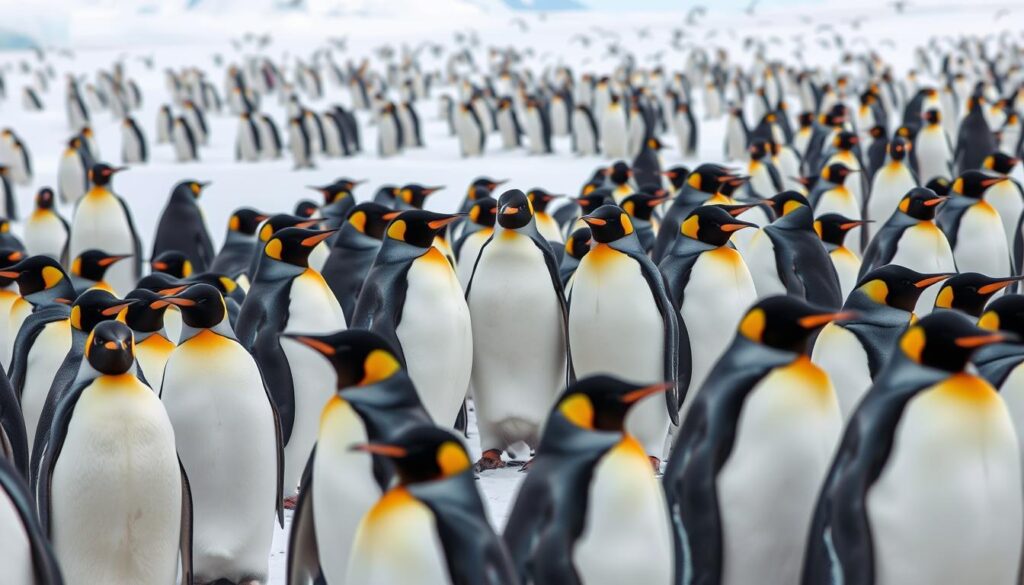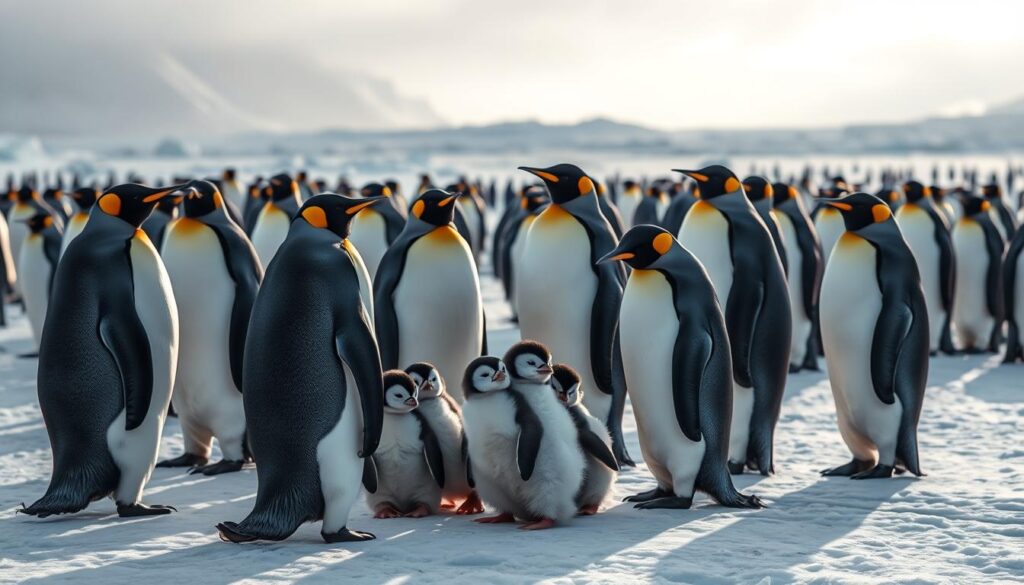Physical Address
304 North Cardinal St.
Dorchester Center, MA 02124
Physical Address
304 North Cardinal St.
Dorchester Center, MA 02124

Have you ever wondered how many penguin species exist? They live in the harsh, yet beautiful, environments of the Antarctic and beyond. There are 18 species of penguins, each uniquely adapted to life in the water and extreme cold.
Penguins are not just charming creatures; they are highly specialized. Their adaptations help them thrive in some of the world’s most inhospitable regions. But, many penguin species are facing big threats from climate change and environmental degradation.
Exploring the world of penguins reveals many fascinating species. They live in harsh environments but thrive. Penguins are very social, living in big groups and showing complex behaviors.
Penguins are well-suited for life in cold water. Their distinctive black and white feathers help them blend in. Their streamlined bodies and powerful flippers make them great swimmers.
They also have interesting behaviors. For example, their complex mating rituals and social behaviors are unique. Penguins live in large groups and communicate with each other in many ways.
Penguins are found in the Southern Hemisphere. They live from the Galapagos Islands to Antarctica. They can be found in rocky coastlines, icy landscapes, and temperate islands.
| Region | Penguin Species | Habitat |
|---|---|---|
| Antarctica | Adélie, Emperor, Chinstrap | Icy landscapes, rocky coastlines |
| Galapagos Islands | Galapagos Penguin | Temperate islands, rocky coastlines |
| Australia | Little Penguin, Fairy Penguin | Coastal regions, islands |

Exploring the different types of penguins is a thrilling journey. These birds are grouped based on their looks, behaviors, and genetics. This helps scientists sort them into various species and families.
Scientists look at morphological characteristics like feathers, beak shape, and size. They also study behavioral patterns like mating and feeding habits. Genetic analysis helps identify species and their evolutionary ties.
There are 18 recognized penguin species, divided into six genera. The table below shows how they are classified:
| Genus | Common Name | Scientific Name |
|---|---|---|
| Aptenodytes | Emperor Penguin | Aptenodytes forsteri |
| Aptenodytes | King Penguin | Aptenodytes patagonicus |
| Pygoscelis | Adélie Penguin | Pygoscelis adeliae |
| Pygoscelis | Gentoo Penguin | Pygoscelis papua |
This system shows the diversity in penguins. It also highlights each species’ unique traits.
Emperor penguins can grow up to four feet tall. They are the largest penguin species and very interesting. Their size and unique traits make them stand out.
Emperor penguins have yellow patches on their chest. These patches stand out against their black and white feathers. Their large size and striking color make them a favorite among wildlife fans.
They have a streamlined body. This helps them swim well in the cold Antarctic waters.

Emperor penguins live in Antarctica. They breed in large groups on the ice shelves. They are well adapted to the cold, with thick fat and feathers to stay warm.
Their home is very cold and windy. But they have learned to survive in these conditions.
Emperor penguins breed in the Antarctic winter. Males incubate eggs on their feet while females hunt for food. This unique behavior helps them survive the harsh winter and raise their chicks.
Emperor penguins can dive up to 1,800 feet deep. They can stay underwater for up to 20 minutes. They are very social, living in large groups and communicating with each other.
Key characteristics of Emperor penguins include:
King penguins are the second-largest penguin species. They are known for their bright colors and interesting behaviors. These birds live in large colonies in the sub-Antarctic islands.
King penguins have bright orange beaks and yellow feathers on their chest and head. Their sleek bodies help them swim well. Their bright colors and regal look make them a favorite among wildlife fans.
King penguins live in the sub-Antarctic islands. They like rocky coastlines and islands. They live in big colonies, sometimes with tens of thousands of birds.
These colonies are on flat or gently sloping areas. This makes it easier for them to breed and care for their young.
King penguins are well adapted to their harsh environment. They are great swimmers, using their flippers to find food. On land, they move in a funny waddle to save energy.
If you love penguins, you’ve probably seen Adélie penguins before. They’re known for their white eye patches. These birds are among the most studied in Antarctica.
Adélie penguins have black and white feathers. These colors help them blend in with the sea and sky. They are sturdy and can grow up to 28 inches tall.
These penguins live along the Antarctic coast and on nearby islands. They like rocky areas for nesting and raising their young.
Adélie penguins are very social and often live in big groups. They are great swimmers, using their wings to move through the water. They search for food this way.
Adélie penguins can drink saltwater because they have a special gland. This gland filters out salt. They also steal stones from other nests to build their own.
| Characteristics | Description |
|---|---|
| Height | Up to 28 inches |
| Weight | Up to 13 pounds |
| Habitat | Antarctic coast and surrounding islands |
Gentoo penguins are a joy to watch with their white stripes and orange beaks. They are fast and agile in the water. This makes them one of the most interesting different types of penguins.
Gentoo penguins stand out with their white stripes and orange beaks. They have a black back and white belly, like many penguins. Their flippers are strong, helping them swim fast.
Gentoo penguins live in the sub-Antarctic islands. They like rocky coasts and islands. They breed in big groups, often where there’s little vegetation.
Gentoo penguins are very social and live in big groups. They swim fast, using their flippers. On land, they move slowly but can waddle.
Their diet is fish, krill, and squid. They catch these while swimming.
Gentoo penguins can swim up to 36 km/h (22 mph). They are also curious and may approach humans.
| Characteristics | Gentoo Penguins | Other Penguin Species |
|---|---|---|
| Speed in Water | Up to 36 km/h | Varies by species |
| Distinctive Features | White stripes, orange beak | Varies (e.g., yellow feathers, crests) |
| Habitat | Sub-Antarctic islands | Antarctic, sub-Antarctic, and temperate zones |
Chinstrap penguins get their name from the thin black stripe under their chin. This unique feature makes them stand out. They live in Antarctica and are very social.
Chinstrap penguins have a black stripe under their chin, black backs, and white bellies. They are medium-sized, growing to about 68-76 cm (27-30 inches) tall. They weigh between 3-6 kg (6.6-13.2 lbs).
Chinstrap penguins live in Antarctica and nearby islands. They nest on rocky coastlines and islands in big groups. Their home ranges from the Antarctic Peninsula to the South Sandwich Islands.
Chinstrap penguins are very social and live in large groups. They are great swimmers, feeding on krill, fish, and squid. They have complex mating rituals and nest together.
Macaroni penguins are a stunning sight in the sub-Antarctic islands. Their unique crests and orange beaks make them stand out. They are one of the most recognizable penguin species.
These birds have black and white feathers and a distinctive crest. Their bright orange beaks and red eyes make them eye-catching. They are about 28 inches tall and weigh 5-8 kg.
Distinctive Features: Their crests and bright orange beaks make them stand out among other penguin species.
Macaroni penguins live in the sub-Antarctic islands. They prefer rocky coastlines and islands. They breed in large colonies, sometimes with other penguins.
| Habitat | Distribution | Breeding Colonies |
|---|---|---|
| Rocky coastlines | Sub-Antarctic islands | Large colonies |
| Islands | Cold climates | Often with other penguin species |
Macaroni penguins have unique mating rituals. They make loud calls and show off. They are also great swimmers, using their wings to move through the water.
Macaroni penguins are listed as vulnerable. This is due to habitat loss and climate change. Efforts are being made to protect their homes and reduce human impact.
Rockhopper penguins are truly captivating. They have unique looks and behaviors. Their distinctive crests and bright red eyes make them stand out.
Rockhopper penguins have distinctive crests and bright red eyes. These features set them apart from other penguins. Their black and white feathers, with a yellow crest, make them a favorite among fans.
These penguins live in the southern Atlantic and Indian Oceans. They prefer rocky, offshore islands. Their home’s rugged terrain matches their bouncy and energetic movements.
Rockhopper penguins are agile on land, hopping with powerful legs. They’re also great swimmers, thriving in the sea. They live in large colonies, showing their social side.
Rockhopper penguins are among the smallest but have a bold and adventurous spirit. Their unique looks and behaviors interest many. They’re a favorite among wildlife observers and scientists.
Did you know the Little Blue Penguin is the smallest penguin in the world? These tiny birds live in the coastal waters of Australia and New Zealand. They have special traits that make them stand out from other penguins.
Little Blue Penguins are the smallest penguins, growing to about 12 inches tall. They weigh between 2.2 and 3.5 pounds. Their blue-gray backs and white bellies help them hide from predators in the sea and sky.
These small penguins call the coasts of Australia and New Zealand home. They live on islands, bays, and coastal areas. They nest in burrows, caves, or under plants, enjoying climates from subtropical to temperate.
Little Blue Penguins are known for their special behaviors. They can swim well, using their wings like flippers. They also have unique calls and can move through dense vegetation.
Little Blue Penguins are interesting creatures. They are monogamous, with many pairs staying together for years. They are also very social, often living in big groups.
| Characteristic | Description |
|---|---|
| Height | About 12 inches (30 cm) |
| Weight | 2.2 to 3.5 pounds (1-1.6 kg) |
| Plumage | Blue-gray back, white belly |
| Nesting | Burrows, caves, under vegetation |
When you see penguins in the wild, knowing how to tell them apart can make it more fun. Each penguin has its own special look, like markings, beak shapes, and feather patterns. These features help them fit in with their surroundings, making them interesting to watch and learn about.
To spot penguins, look for these important signs:
By noticing these details, you can better figure out which penguin you’re seeing.
Penguins live in different places around the world. Here are some top spots to see them:
Going to these places lets you see many penguin types in their natural homes.
Many penguin species are at risk of extinction. It’s vital to know the threats they face and the conservation work being done. Penguins, with their unique diversity, are facing severe challenges that threaten their survival.
Penguin populations are under threat from climate change. Rising temperatures are melting sea ice, which is essential for them. Overfishing also harms penguins by reducing their food supply. Pollution and coastal development are destroying their habitats.
Efforts are being made to save penguin populations and their homes. Organizations are creating protected areas and monitoring penguin numbers. They also educate people about the need to protect penguins.
You can help by supporting conservation groups, reducing your carbon footprint, and sharing information about penguins. Every small action can help a lot. Together, we can make a big difference.
Exploring the different penguin types shows us how unique each species is. From the huge Emperor Penguins to the tiny Little Blue Penguins, their variety is amazing.
It’s important to understand and appreciate these birds for their survival. Knowing about penguins and their homes helps us protect them. This knowledge supports efforts to save these amazing creatures for the future.
You can help by supporting groups that work to save penguins. Also, sharing the need to protect their homes is key. Every little bit helps, and together, we can protect these incredible birds for a long time.